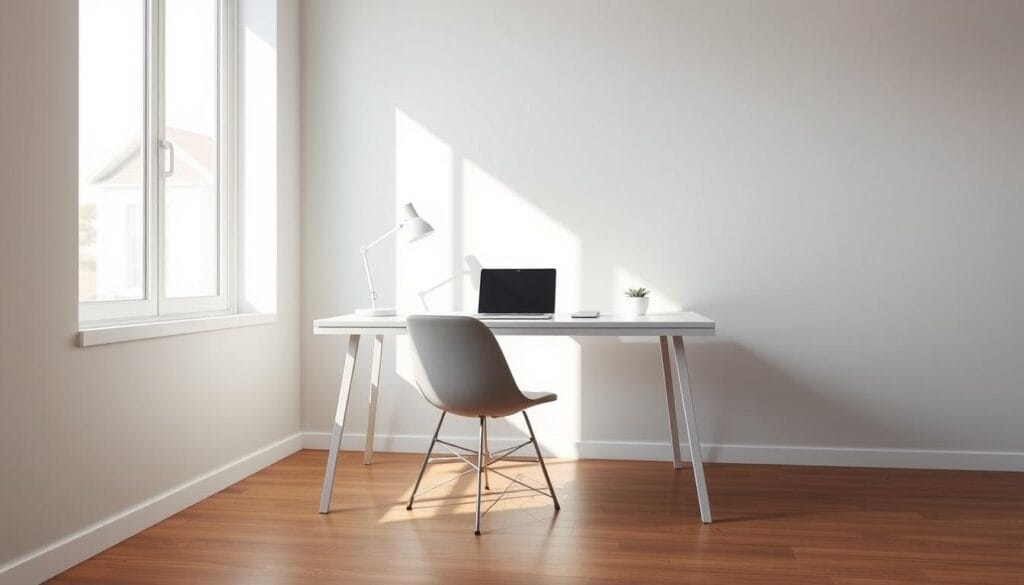Imagine a room that instantly soothes you. That’s minimalist interior design for you. I visited a friend’s place in New York City last summer. Walking in, the space felt like a sigh of relief. It had neutral colors, sleek furniture, and a brilliantly simple vibe. It wasn’t just good-looking; it was also practical and calming.
Minimalist interior design came about in the mid-1960s. It was an answer to the over-decorated homes of the time. It’s more than just a look; it’s a way of life. Choosing minimalist decor helps clear our minds and soothes us.
We’re going to look at what makes minimalist design so great. We’ll give you tips to turn your place into a peaceful retreat. We’ll cover the philosophy of minimalism and the key parts of minimalist decor. Let us help you create a beautifully simple home.
Are you ready to see how minimalist design can change how you live? Let’s start!
Understanding Minimalist Interior Design
Let’s explore the charm of minimalist interior design. It’s all about the “less is more” approach. It focuses on keeping only what’s needed and removing the rest. This design style started in the early 20th century. It aims to create peace and encourage mindfulness by combining beauty with simplicity.
The Philosophy Behind Minimalism
Minimalism in interior design means keeping only what’s truly important. It’s about clean lighting, careful placement of items, and a balance of perfect elements. Simplicity in design helps us make spaces that are purposeful. These spaces give us freedom and a break from the busy world around us.
It’s not just about having fewer things. This idea helps clear our minds and bring inner peace.
Benefits of Minimalist Living
Choosing to live simply comes with many advantages. It can lower stress, keep things organized, make spaces look bigger, and make cleaning easier. For example, using calm colors like white, gray, and earth tones can make a place feel more peaceful. Brands like MUJI Hotel show how minimalist design can offer a relaxing stay.
By choosing a minimalist lifestyle, your home can be clutter-free, calm, and easy to manage.
Key Elements of Minimalist Design
Minimalist design focuses on simplicity, functionality, and blending form with purpose. It became popular from the 1960s to the 1980s, offering a simple contemporary lifestyle. The main parts are the color palette and furniture selection.
Color Palette: Neutrals and Beyond
In minimalist designs, muted colors are often the first thing noticed. White, beige, gray, and soft pastels are common, creating a calm background. These colors make spaces feel peaceful and let other design parts stand out, with 60% of people feeling more relaxed in such environments.
But, minimalist design also adds color through art or decor, making rooms feel 30% bigger. This keeps the look simple yet interesting.
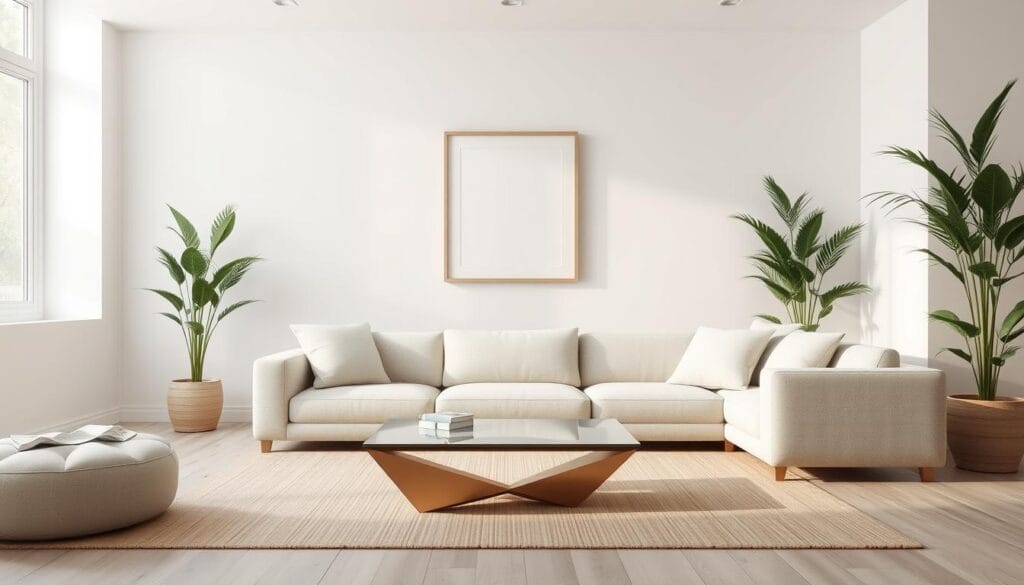
Furniture Selection: Functional and Stylish
Furniture in minimalist areas must be functional with clean lines, as 55% of designers say clients want these features. Most furniture should be multi-use, like a sofa bed or a coffee table with storage. This mixes looks with usefulness.
The idea is to have fewer things, only keeping what’s important. This can make spaces less crowded and reduce stress, with 70% of homeowners feeling calmer. Choosing our furniture this way makes our homes look good and work well.
###
Creating Space with Layout
Creating a minimalist space means having an open floor plan. This helps people move freely between areas. It’s not just about looking good; it’s also about being practical. A home with less clutter reduces stress and keeps us focused.
By choosing minimalism, you’re following a “less is more” approach. This keeps your home neat and simple.
Open Floor Plans: Maximizing Flow
An open floor plan makes a home feel bigger and full of light. By taking out unneeded walls, the living, dining, and kitchen areas connect better. Imagine a living room with just a couch, chair, coffee table, and a few lamps. This not only looks good but is easier to clean.
A simple room can be cleaned faster than one that’s full of stuff.
Strategic Furniture Placement
Putting furniture in the right place keeps a minimalist home balanced and peaceful. Every piece should have a purpose and look good. Often, flat surfaces will have one or two decorations, like flowers.
Floors are kept clear, and walls have one or two simple artworks. This keeps the space looking unified.
Start by simplifying one room at a time, focusing on big items. Give every item a specific spot. Regularly remove things you don’t need. This keeps your space feeling open and tidy.
Use a small table to help organize your minimalist efforts:
| Task | Effort | Impact |
|---|---|---|
| Open floor plan layout | High | Significant increase in flow and light |
| Furniture placement | Moderate | Enhanced functionality and aesthetics |
| Decluttering surfaces | Low | Reduced visual stress |
Following these steps helps create a minimalist space that’s both beautiful and functional. It turns a cluttered area into a calm retreat. Remember, the secret of minimalism is making a space simple and serene.
Light and Texture in Minimalism
Mixing light and texture carefully changes the game in minimalist design. It turns a simple space into a warm, welcoming area that’s stylish and well-planned.
Natural Light: The Best Illumination
Natural light is a top pick in minimalist design 🌞. It fills every nook with life, shows off clean shapes, and makes spaces feel open. Imagine big windows and doors letting in lots of sunlight to brighten your home.
Adding large windows or skylights can make a real difference. Using glass details with more solid parts makes natural light stand out more and look amazing.
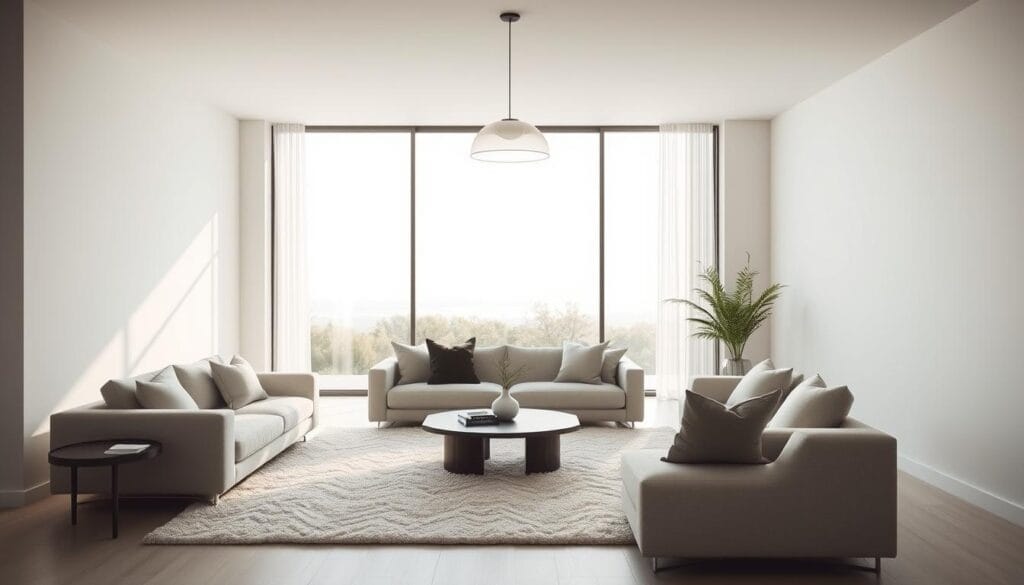
Incorporating Textures for Depth
Textures bring depth and warmth to simple spaces. Using gentle touches like stoneware, wood, and fabrics makes the look appealing. Mixing soft rugs with sleek wood floors is a smart move. It highlights the design’s simplicity and adds variety.
With furniture, think of unique wooden chairs or a stylish leather sofa. Keep things balanced with up to three colors. Use mostly neutral shades, some soft colors, and a bit of bright accents for a well-matched look. Tone-on-tone art highlights key furniture without being too much.
For more great advice, check out this in-depth look at minimalist interior design.
Adding different lights can make the space feel cozy. Backlit mirrors or art give off a gentle light that keeps the area from looking empty. The goal is to mix these elements in a way that’s useful and soothing.
Essential Design Principles to Follow
Mixing minimalist home decor with key design rules can make your home calm and functional. It’s all about finding the right balance and making everything in the room work together well.
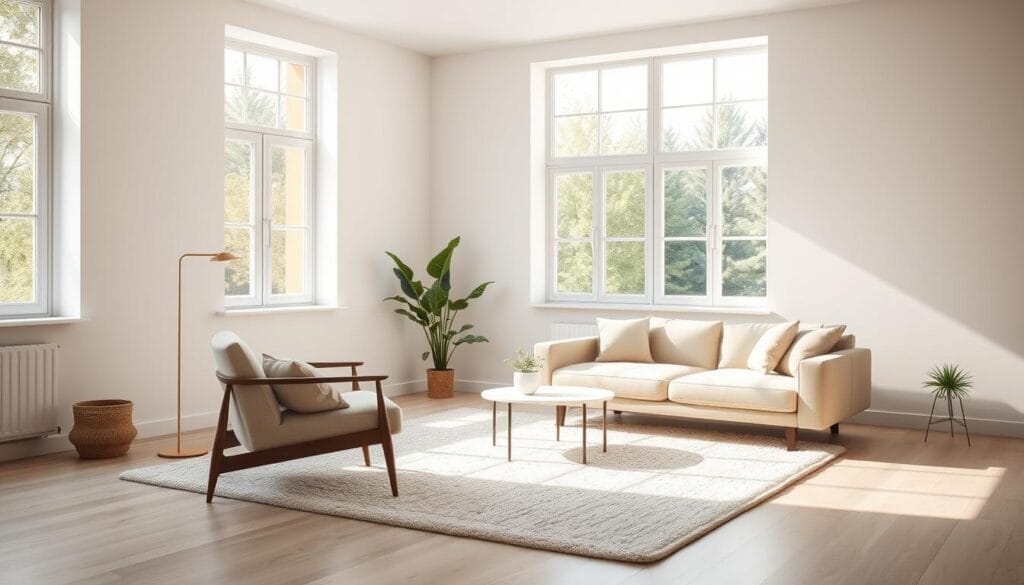
Balance and Harmony in Décor
To get balance, everything in the room should be arranged just right. This can mean using big cabinets in kitchens to increase storage but still keep the space looking open. To create harmony, stick to one color theme, using different shades and textures to keep things interesting yet peaceful.
Emphasizing Functionality over Ornamentation
In minimalist decor, having less means more. Only keep things that are really needed, avoiding too much decoration. Using lots of open space and natural light makes everything feel calm and easy to use. Studies show that minimalist office designs can make you 20% more productive and 15% more focused because there are fewer distractions.
Adding green plants can also make your home look better and the air cleaner, boosting well-being by 15%. The key is to choose fewer, but better-quality things that both look good and are useful.
For more tips on creating beautiful, functional minimalist spaces, check out Design and Dwelling.
Choosing the Right Materials
When picking materials for a minimalist look, your choices matter a lot. They shape the room’s look and show your love for simple, eco-friendly living. Using wood, glass, and metal together gets you that minimalist vibe you’re after.
Sustainable Options for Minimalist Homes
Going green is key for a minimalist home. Use natural stone, like marble or travertine, for floors and counters. It looks luxurious and raises the room’s design. Light wood types, such as beech or ash, bring warmth and a natural feel. They’re good for the planet and keep things simple, just like minimalism likes it.
| Material | Properties | Uses in Minimalist Design |
|---|---|---|
| Marble | Luxurious, durable | Flooring, Countertops |
| Beech Wood | Light-toned, warm | Flooring, Furniture |
| Linen | Soft, natural | Upholstery, Rugs |
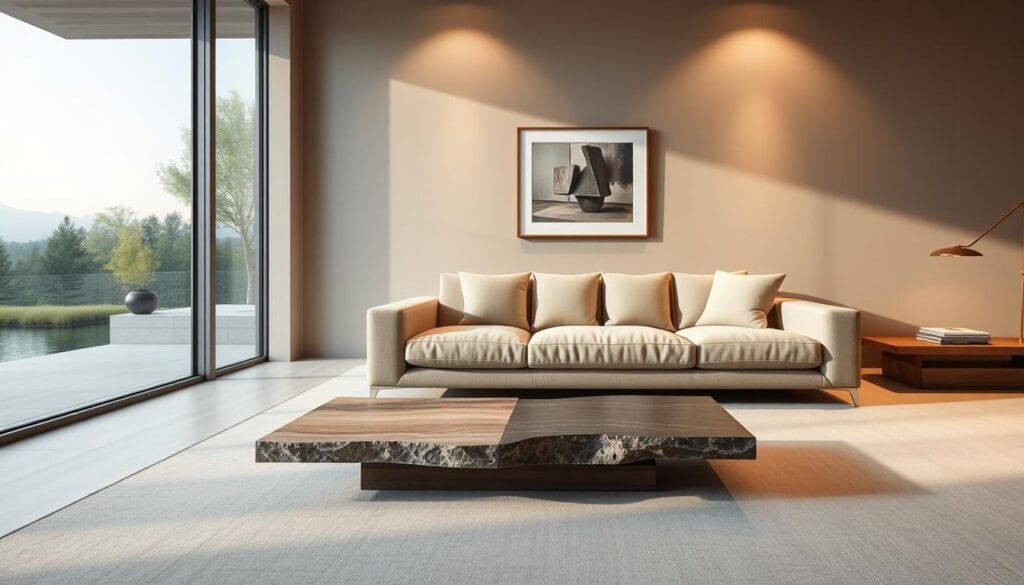
The Role of Wood, Glass, and Metal
Wood, glass, and metal are essential in minimalist designs. Metals like stainless steel add a modern edge, used in details and fixtures. Glass brings in light and openness with big windows and sleek panels.
Choosing light wood adds warmth without filling up the room too much. Adding bits of glass and metal gives the place a sleek, modern look. This mix is just what you need for that minimalist feel.
Tips for Decorating Minimalist Spaces
When decorating in a minimalist style, it’s important to choose items carefully. Each piece should enhance the room while keeping it simple and clean. This approach ensures your space feels open and calming. Let’s look at ways to pick accessories and art that make your room stand out without making it feel too busy.
Accessorizing with Intent
Introducing accessories into your minimalist space should aim to keep things tidy but add some personality. Using elements like wood, stone, and natural fabrics can keep the look interesting but not overwhelming. For kitchens, consider open shelving instead of upper cabinets to make the room feel more open. Items from IKEA can also help make your kitchen look more spacious. In small rooms, such as bathrooms or bedrooms, choosing white walls can help make the space feel brighter and bigger.
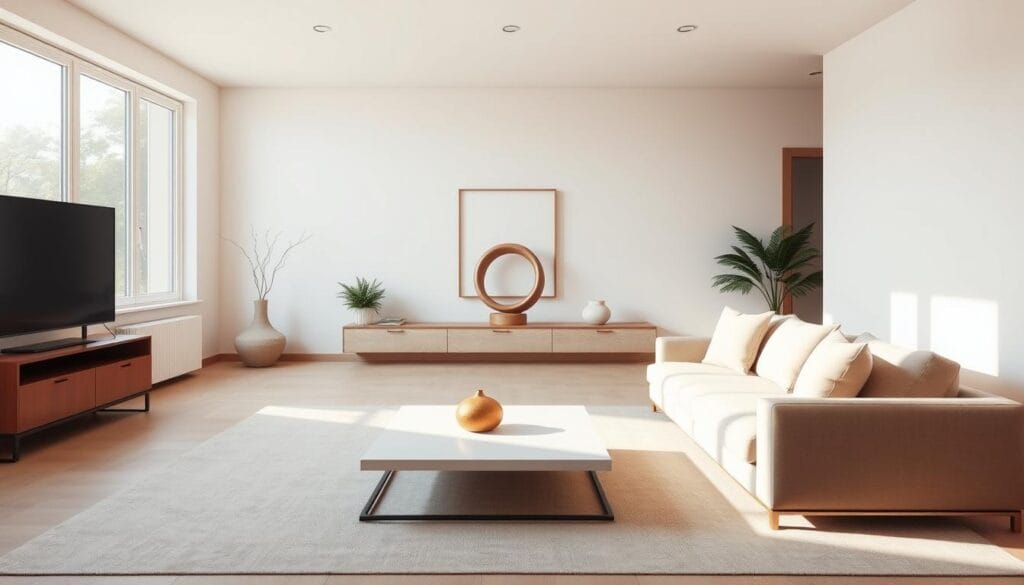
Art Choices that Speak Volumes
Choosing art for a minimalist space means picking pieces that attract attention but don’t clutter. Leave empty space around artwork to draw the eye to these key spots. Many prefer to create a gallery wall that looks striking without filling up the room too much. Clear frames can help keep the art in the spotlight, making the room look nicer.
A simple bed with neutral decorations helps keep a bedroom looking neat. This lets a single piece of art really shine. You can also add vintage or reclaimed items to add charm without mess.
Minimalist decorating is great because it helps make your home a peaceful, inviting place. Each choice, like deciding on a vase or a book, should be made thoughtfully and deliberately.
Common Mistakes in Minimalist Design
Starting a minimalist design journey can be fulfilling, but it’s easy to slip up. To keep your space stylish and cozy, know what mistakes to dodge.
Overcomplicating Spaces
Adding too many materials or styles can mess up a minimalist design. Minimalism is about simplicity and beauty. Choose quality over quantity for an open, welcoming look. Remember, less is more.
- Use a simple color scheme to avoid a messy look. Over 3500 Benjamin Moore colors can help you pick just right.
- Go for natural materials like wood and stone, which 80% of designers think don’t overwhelm the design.
- Choose furniture that serves multiple purposes to keep your space neat and true to minimalism.
Neglecting Personal Touches
Forgetting to add personal touches can make a space feel cold. Simple doesn’t mean no character. Personal items like family heirlooms or photos add warmth. 70% of designers say adding color in minimalist kitchens boosts warmth and appeal.
- Make sure 10-20% of your decor is personal to keep your space interesting.
- Include art and accessories to avoid a bare look, recommended by 90% of designers.
- Use smart storage like baskets and ottomans to cut down clutter by 50%, making your home both tidy and inviting.
Avoiding these mistakes helps you excel in minimalist design. This way, your minimalist space is both useful and lively.
Inspiring Minimalist Interior Design Examples
Minimalist interior design is all about elegant simplicity and focusing on what’s essential. This design approach has been loved since the 1960s for its timeless appeal. It’s more than just how things look; it’s about a way of living that loves natural light, outdoor connections, and calm spaces. This “less-is-more” way of thinking creates peaceful homes.
Homes that Exemplify Minimalism
Some homes really show off the beauty of minimalism. They often use natural materials, like wood and stone, because they value sustainability. Take minimalist kitchens, for example. Many prefer open shelves instead of upper cabinets. This choice makes the space feel open and free.
Choosing a simple color scheme, like soft beige, black, and gray, brings everything together. Then, adding big, bold pieces of art or furniture makes a simple yet strong statement. When it comes to accessories, less is more. Keeping them to a minimum makes the room look better without feeling cluttered.
Influential Designers in the Minimalist Movement
Some really important designers have helped shape what minimalism is today. Ludwig Mies van der Rohe famously said “less is more.” John Pawson is known for his very simple designs. Their ideas focus on creating spaces that are bright and open. They love using natural light.
These designers believe in making room feel spacious and choosing furniture that’s both timeless and useful. By doing this, spaces not only look good but are practical too. This way of designing helps keep rooms looking great without too much stuff.
Minimalist interior design keeps changing, but its main ideas like simplicity, loving nature, and being kind to our planet will keep influencing home decor. With inspiring people and real homes to look at, we’re all invited to live in peace and intention. This includes how we design our homes, now and in the future.


